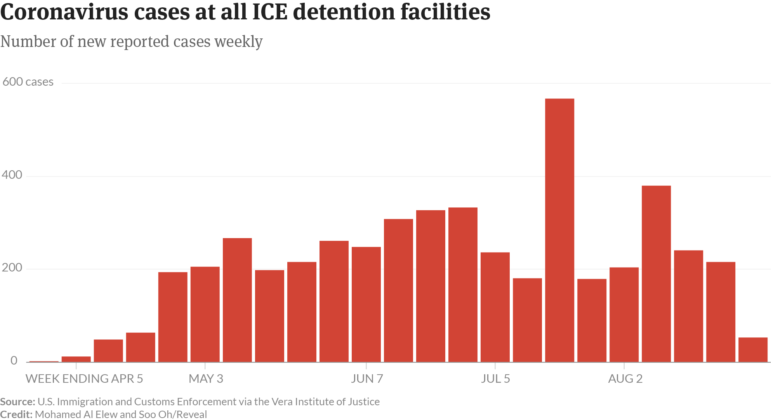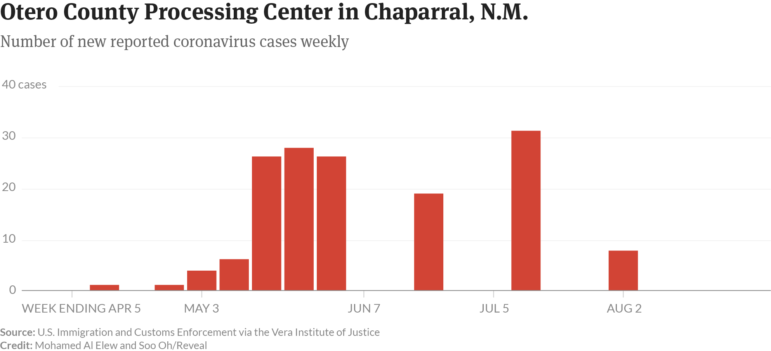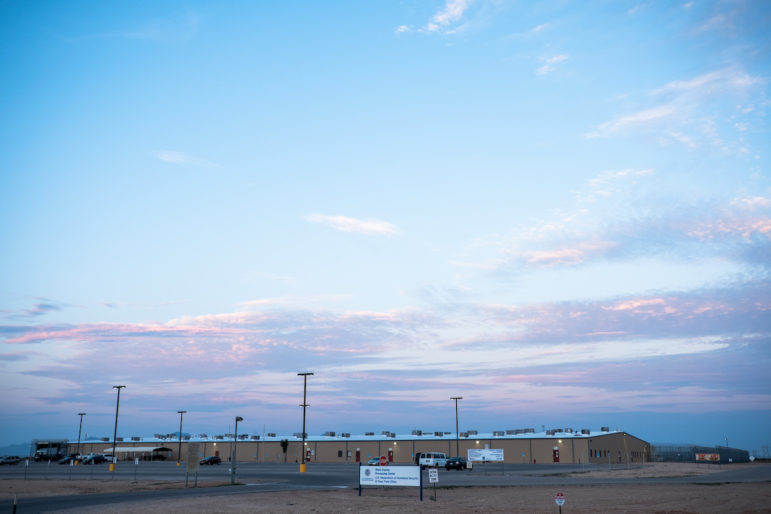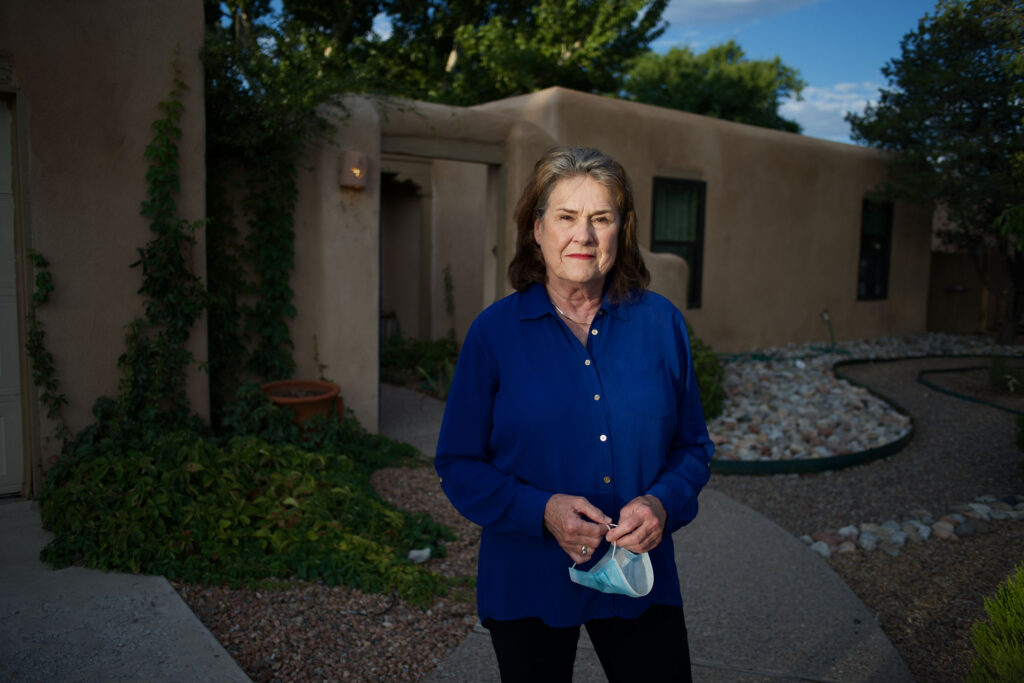This story was produced by Reveal from The Center for Investigative Reporting, a nonprofit news organization. Get their investigations emailed to you directly by signing up at revealnews.org/newsletter.
Kathy Kunkel, secretary of the New Mexico Department of Health, was frustrated.
She was getting reports the first week of May of horrifying conditions at the Otero County Processing Center, one of three U.S. Immigration and Customs Enforcement detention facilities in the state. Detainees were responsible for disinfecting their own living spaces but weren’t getting adequate cleaning supplies. Their sheets hadn’t been washed for a month. Social distancing was impossible inside housing units shared by dozens of men.
Kunkel’s staff had been calling the center repeatedly. She wanted to stop new transfers to Otero from other states to reduce the risk of a coronavirus outbreak. She didn’t know where to turn.
So she pulled out her iPhone and typed a message to Dr. Alexander L. Eastman, the senior medical officer at the Department of Homeland Security. “Can you help me in this? We sent 500 tests. They don’t answer calls.”
She hit send. Eastman previously had told her that it was “iffy” whether he had any authority to step in because Otero, 30 miles north of downtownEl Paso, Texas, is run by a private prison operator, Management and Training Corp. After reading her latest note, he changed his tune: “Have escalated to ICE top leadership. Will circle back.”
It was too late. Otero has since become one of the ICE facilities hardest hit by the pandemic, despite the fact that New Mexico’s public health experts repeatedly offered their help and expertise to slow the spread of COVID-19.

Internal emails obtained by Reveal from The Center for Investigative Reporting provide a behind-the-scenes look at the frustration that built up over months within the New Mexico Department of Health as officials with ICE or its contractors failed to test detainees exposed to the virus – or turned down vital testing assistance. State officials sought to control the spread of the virus at detention centers – including county jails and ICE facilities – worried that a COVID-19 outbreak in a correctional setting could spread into the community.
Kunkel, 69, is straightforward, avoiding the government jargon that leaders often fall back on in times of crisis. She began her career as a pediatric social worker at the University of New Mexico. After getting her law degree, she joined the state attorney general’s office, going on to become general counsel and then deputy director for the Department of Health. Last year, Democratic Gov. Michelle Lujan Grisham appointed Kunkel as health secretary.
Now Kunkel is managing the state’s pandemic response from a command center at the dining table in her Albuquerque home. She’s led an aggressive effort to test, trace and contain burgeoning outbreaks across businesses, schools, child care centers, hospitals, nursing homes and corrections facilities. The effort is one piece of the assertive response to COVID-19 in New Mexico, where officials closed schools early and rapidly organized free testing. The result: As of early August, New Mexico’s positivity rate of 1 in 30 tests was much lower than in neighboring states such as Texas, where 1 in 6 tests were coming back positive, and Arizona, where the rate was 1 in 4. New Mexico is also among the states with the lowest number of cases per capita.
But ICE repeatedly stonewalled the health department’s efforts. ICE continued detainee transfers, despite warnings from Kunkel’s staff that such movement could spread the virus. And as Kunkel rolled out a state plan to test every person in detention, ICE officials failed to return the department’s calls – or secure enough of their own test kits.
In the early days of the pandemic, any positive COVID-19 test result was a threat, Kunkel told Reveal.
“We wanted to respond quickly and provide support as time went on. We needed their cooperation to do it more effectively and to cooperate with us,” she said of ICE. “That, unfortunately, didn’t always happen.”
ICE disputed the version of events chronicled in state records obtained by Reveal. The agency declined to comment on detainee transfers, citing a pending lawsuit against the agency. But in a statement, an agency spokesperson said medical personnel at Otero “maintained open lines of communication” with the health department during the “collection and processing of COVID-19 tests during the voluntary saturation testing of all detainees at the facility.”
But a New Mexico Department of Health spokesperson disagreed: “ICE has not maintained open channels of communication with DOH,” Jodi McGinnis Porter told Reveal in an email.
Kunkel only could look on from the outside as COVID-19 cases slipped out of control at Otero. At a time when testing kits were scarce, health department staff had no idea whether the 500 they sent to Otero had even been used.
Kunkel, state Corrections Secretary Alisha Tafoya Lucero and Dr. Chad Smelser, the state’s lead COVID-19 epidemiologist, described ICE as slow to track and control the coronavirus and reluctant to accept the state’s help.
“We have to be concerned about every person in New Mexico, every single person,” Tafoya Lucero said. “It continues to be a source of frustration to feel like, and to see, that these people who really should be on board with us enthusiastically – to protect the population that we serve in an institution – that they’re not following through.”
Emails show that wardens and health administrators for Management and Training Corp. and CoreCivic, the other private contractor running ICE facilities in New Mexico, mostly responded to health department inquiries. The resistance came from ICE, which over a period of months failed to return phone calls and comply with the state’s plan to conduct testing at all detention facilities, officials told Reveal.
ICE has maintained that it is safely managing the coronavirus risk. “ICE is firmly committed to ensuring the health and safety of individuals in its custody, its employees, contractors, and the general public,” one top ICE official, Henry Lucero, told Congress in June.
According to Lucero and other statements issued by ICE, the agency has been following guidelines from the Centers for Disease Control and Prevention, providing detainees with sanitizer and soap, and reducing the population in detention centers to promote social distancing. Detainees who test positive, the agency says, “receive appropriate medical care.”
Yet according to public health experts, detainees live and sleep in cramped quarters where social distancing is impossible. ICE has refused to free many immigrants who qualify for release, either through bond or parole. More than 5,000 detainees have tested positive since the start of the pandemic, ICE figures show. So have 1,000 employees, according to recent congressional testimony. About 600 detainees are currently positive for COVID-19 within ICE’s detention network, which currently holds more than 20,000. Six detainees and at least two guards have died from the virus.
And those are just the outbreaks ICE has publicly acknowledged. Researchers say the agency’s official tally of COVID-19 cases is almost certainly a vast undercount because so few detainees have been tested. When the Vera Institute of Justice, a social justice advocacy nonprofit, modeled the behavior of COVID-19 on the ICE detention system, it found the true case total “may be up to 15 times higher than the figures reported by ICE as of mid-May.”
The records that Reveal obtained from New Mexico and a handful of other states underscore the likelihood of an undercount: ICE isn’t testing. The federal government provides ICE with 5,000 test kits a month, but officials say most of those are used for screening detainees as they enter the system and before they board deportation flights, rather than on regularly testing thepeople in detention. ICE contractors source additional tests for their own facilities, but the net result is a huge shortfall. At Otero, Kunkel said, staff said the facility would get very few tests without the state’s help. As of July, 415 detainees were being held at Otero.

ICE’s failure to comprehensively test, combined with its continued practice of transferring detainees, has fueled new outbreaks all over the country. Immigration Centers of America, which runs a detention center in Farmville, Virginia, initially turned down the state’s offer to help with testing “without an explanation,” said Dr. Robert Nash, regional director for the Virginia Department of Health. Detainees in Farmville have experienced the worst outbreak of any ICE facility in the country, with 339 detainees testing positive so far. In early August, the Associated Press reported that 259 of Farmville’s 298 detainees had the virus.
At the Mesa Verde ICE detention center in Bakersfield, California, emails disclosed in a court case suggest that ICE rejected a medical contractor’s plan to test all its detainees because the agency wouldn’t have room to isolate everyone who tested positive.
Inside one of ICE’S biggest outbreaks

The Otero County Processing Center just outside Chaparral, New Mexico, can house just over 1,000 people. Credit: Joel Angel Juárez for Reveal
The Otero County Processing Center opened its doors in 2008 just outside the small town of Chaparral, New Mexico. It can house just over 1,000 people and is overseen by a staff of about 300. The building blends into the desert around it, wrapped in khaki-colored corrugated siding. It is surrounded by a double wall of chain-link fence and concertina wire and fronted by a covered walkway built with detainee labor.
The facility is part of a 15-acre complex that is also home to the Otero County Prison Facility, which holds up to 1,400 federal and state prisoners. Both facilities are operated by Management and Training Corp., a Utah-based prison contractor.
Although a sign outside describes Otero as an ICE facility, day-to-day decisions are made by Management and Training Corp. It’s the same across the ICE detention network, with the agency relying on private companies and local jails to house detainees.
One of those detainees landed in Otero in early April. The government had held him in El Paso for a week, from March 27 to April 4, before sending him 30 miles away to Otero.
Within two days, the new detainee had developed a fever, cough and sore throat. On April 7, the detainee was tested for COVID-19. He appears to be the first confirmed case of the virus in a New Mexico ICE facility.
Otero officials placed him in isolation in the medical unit. But by then, he’d already come in contact with at least 74 other detainees. Rather than test them all immediately, the facility placed them under quarantine for 14 days.
This practice, called cohorting, has become standard ICE practice during the pandemic. Ada Rivera, medical director for the ICE Health Service Corps, told Congress in June that cohorting “is recommended by CDC guidelines.” But those guidelines actually say that “cohorting should only be practiced if there are no other available options.” As Mother Jones reported, cohorting without testing can be dangerous because people without symptoms can easily spread the virus to others in their quarantine unit. Only testing and isolation can prevent that.
After the detainees had been quarantined for more than a week, Otero health services administrator Guillermo Contreras decided he wanted help to test more widely. He called one of the state health department’s epidemiologists, Sandra Melman.
On April 15, Melman wrote details of the call for Kunkel and other colleagues. “They would now like to test them all and are asking for our assistance to do so. They do not have enough testing capacity.”
The department responded by sending 500 to 600 tests, officials say.
One week later, 25 detainees arrived at Otero. One of them, records show, had come from the Otay Mesa Detention Center in San Diego. He had developed a cough, body aches and congestion days earlier and was awaiting the results of a COVID-19 test.
Hours after the detainee arrived, Contreras received word that the test had come back positive. He wrote again to the health department with the bad news.
A day after Contreras’ email, Kunkel got another update on the transfer, this time from Smelser, the acting state epidemiologist.
Smelser told Reveal that he has been advocating for more than a decade for ICE to monitor detainees being transferred into and out of New Mexico for infectious diseases such as chickenpox and measles. Now, in his message to Kunkel, he wondered why ICE would want to further strain a facility struggling to contain an outbreak by adding more possibly contagious people to the mix.
“I have never understood the reasons or protocols for these transfers,” he wrote. “Do you have any suggestions on how to deal with this? Could we get a senator to complain?”
Warnings of an ‘alarming situation’
The outbreak already was brewing at Otero. On May 8, a member of Gov. Michelle Lujan Grisham’s staff forwarded Kunkel an email from an advocate, warning of an “alarming situation” there. Margaret Brown Vega, a volunteer who supports people detained by ICE, wrote that Otero detainees with COVID-19 symptoms still had not been tested.
“It is unclear to what degree, or how, the state or county health departments are overseeing what is happening,” Brown Vega wrote.
Kunkel quickly wrote two messages to her staff from her iPhone. In one, she asked a staff member to call and get more information. In the other, she decided to go higher up the chain at ICE. She said she wanted to stop transfers from other states:
“I called dr Alex Eastman in this last week and he said USDHS authority “iffy” due to contractor manager. We continue to call daily to medical director. Sent over 500 test kits. We are trying to get in there; also want to stop transfer if detainees from other states. Continue to work it”
Kunkel had met Eastman, the top medical official for the Department of Homeland Security, the previous year when he was working with states as asylum seekers were arriving in record numbers.
Eastman told Kunkel in an email that he had flagged the issue for top ICE leadership. But she said he also warned her that the response “was not going to be very strong.” The agency would not make Eastman available for an interview.
It wasn’t just Otero. On May 18, in response to an email from Kunkel ordering her staff to contact county detention facilities for testing, state surveillance officer David Selvage wrote:
“All 3 ICE facilities are a challenge… As of last week when I spoke to Warden Chad Miller at (Torrance County Detention Facility, managed by CoreCivic), he was adamant that his company would not permit universal testing of the ICE and US Marshal holds. I think that they all need to be tested, but that is my opinion. I believe that the US Marshal holds have a fairly high infection rate.”
A CoreCivic spokesperson said in a statement that leadership at the Torrance facility and the Cibola County Correctional Center, the other ICE facility CoreCivic runs in New Mexico, have been “in frequent communication” with health department officials, including Selvage. “We have rigorously followed the guidance of local, state and federal health authorities, as well as our government partners.”
State officials’ struggles to get through to ICE would continue in the coming months.
Appeal from the governor
In June, Lujan Grisham assigned Tafoya Lucero, the corrections secretary, to establish a line of communication with ICE. At first, the agency appeared open to finally cooperating. As Tafoya Lucero recalled, “Suddenly, the leadership from ICE, they were returning my phone calls.”
But two weeks later, when the secretary asked ICE to provide its own test kits and stop transfers in and out of Otero, the officials went silent, Tafoya Lucero said.
In mid-July, Scott Marquardt, president and CEO of Management and Training Corp., which runs Otero, was called to testify before the House Homeland Security Committee. Marquardt held up the widespread testing at Otero as a mark of his company’s commitment to containing COVID-19.
“We have administered multiple rounds of extensive testing for the 467 individuals in the facility, administering 794 tests,” he said.
But beyond saying that “MTC has worked closely with ICE and state and local health departments,” he didn’t acknowledge that New Mexico had provided the bulk of those tests. The company declined to answer Reveal’s questions about its testing at Otero.
Today, the health department says ICE still is not testing detainees inside Otero at the level it recommends.
After the aggressive intervention from Kunkel and her health department, the outbreak at Otero has apparently died down. In all, 150 detainees contracted COVID-19 there. As of Sept. 9, there were no active cases at the facility. But with continued transfers from other facilities and a lack of tests to keep monitoring the population, another outbreak remains possible.
Tafoya Lucero said her calls to ICE still go unreturned. She says it disturbs her that the welfare of so many people in custody in her state are out of the health department’s reach[1].
“My concern is,” she said, “are they endangering people?”
This story was edited by Andrew Donohue and Esther Kaplan and copy edited by Nikki Frick.
Patrick Michels can be reached at [email protected], and Laura C. Morel can be reached at [email protected]. Follow them on Twitter: @PatrickMichels and @lauracmorel.
